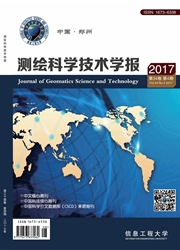

 中文摘要:
中文摘要:
采用最小二乘法代替傅里叶系数计算公式来确定谐波系数,使用若干个磁静日的谐波系数均值作为磁扰日的谐波系数,再取一定截断阶数的傅里叶级数作为太阳静日变化模型。以此进行地磁观测数据中太阳静日变化和磁扰的分离。然后对日变站太阳静日变化进行地方时差校正得到测点处的太阳静日变化,将其与地磁扰动一起用于测点的日变改正。通过台站数据的计算结果分析了模型的截断阶数、日变站与测点间的经度差等因素对日变改正精度的影响,并对比了此方法与扰日法的改正效果。结果说明了此方法的合理性与可行性。
 英文摘要:
英文摘要:
In the paper, the least square method is used to replace Fourier coefficients calculation formula for cal- culating harmonic coefficients, then the average value of magnetically quiet day' s harmonic coefficients is used as magnetically disturbed day' s harmonic coefficients, and the truncated Fourier series are taken as the model of geo- magnetic daily quiet variation in the magnetically disturbed day. Then the model is used to separate the geomagnet- ic daily quiet variation and geomagnetic disturbance from observation data, the geomagnetic daily quiet variation of observation point is acquired by correcting the geomagnetic daily quiet variation of diurnal variation station with the local time difference. Finally, the geomagnetic daily quiet variation of observation point and geomagnetic disturb- ance are used to correct the diurnal variation of observation point. The influence of the factors including the trunca- tion order of model and longitude difference between the diurnal variation station and observation point on the accu- racy of diurnal variation correction is analysed through calculating the geomagnetic observatories' data. The effect of the method put forward in the paper and disturbed method are compared. The experimental result shows that the least square-harmonic modeling method is reasonable and feasible.
 同期刊论文项目
同期刊论文项目
 同项目期刊论文
同项目期刊论文
 期刊信息
期刊信息
